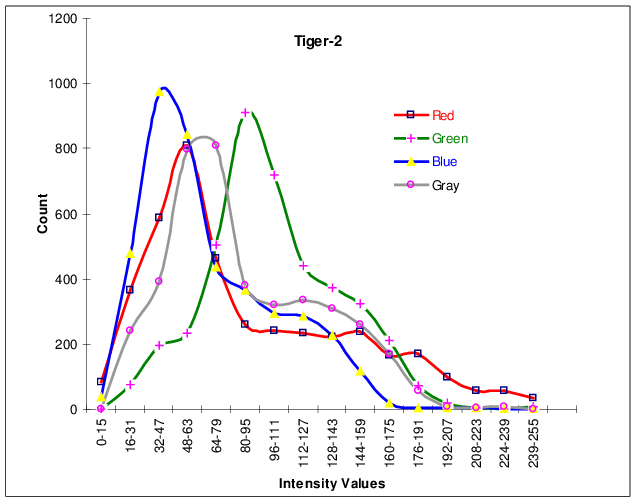Jig: Hierarchical Tree
 Derek & Laura Cabrera
·
4 minute read
Derek & Laura Cabrera
·
4 minute read
Excerpt from the book: Systems Thinking Made Simple, Chapter 8
This blog is part of a set of blogs under the tag "cognitive jigs." Be sure to checkout the tag to read them as a group and learn how cognitive jigs are at play in our everyday lives.
Hierarchical trees are pervasive and popular ways to organize information. All hierarchical trees are part-whole structures so when you see one in any context, just remember that the Systems Rule is at work. The problem is that when individuals use the Systems Rule exclusively (without relationships, distinctions, or perspectives), they inevitably end up in a thinking cul de sac. Part-whole hierarchies or trees are good to use, but they are not good enough.
One of the most popularized hierarchical trees is called a Mind Map. Even if you’ve never used a mind map, you have likely seen one and even if you haven’t seen one, you’ve likely been influenced by one. Mind Maps aren’t popular because they’re good at anything, they’re popular for the same reason that Cheetos are popular: not because they are packed with nutrients, but because they taste good. Mind Maps are easy to use and easy to feel successful with, but they lead to visual malnutrition.
To use Mind Maps is to love them. They are simple and seductive. They make us feel like we are getting somewhere, understanding things better, getting our thoughts on a page. But Mind Maps are based exclusively on a radial, centralized cognitive architecture that is not only scientifically invalid, but meta-cognitively destructive. The cognitive style of Mind Maps, like the cognitive style of PowerPoint, causes thinking and communication biases. Mind Maps always result in a radial hierarchy even if that is not how the system being thought about is structured. Mind Maps make your ideas worse by forcing you to think inside of unnatural hierarchical and radial structures, which reinforces bad habits in systems thinking. They also increase map junk—unnecessary use of color and clip art that hides the overly simplistic structure of this technique.

Many people are fooled into thinking Mind Maps are creative, mind expanding, divergent thinking tools when in actuality they are structurally no different than organizational charts (org charts). Few people would argue that an org chart is the height of creativity, innovative thinking, or systems thinking. Yet notice that the two maps in Figure 8.14 are structurally the same. The diagram on the left is an org chart or hierarchical tree structure in four directions. Likewise the Mind Map on the right is a hierarchical tree in five directions (five black arms emanating out of the creepy eyeball).
Both maps are structurally based on hierarchies radiating outward from a central point. How do the added color, clip art, and fonts increase understanding, creativity, divergent or systems thinking? The answer is, they don’t.
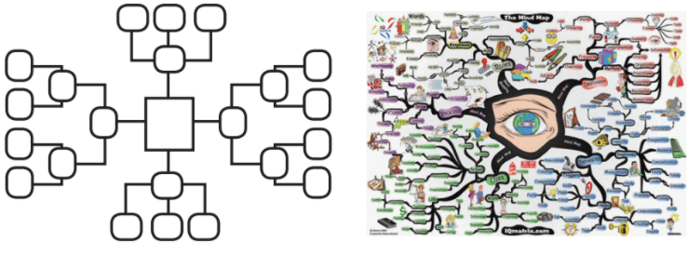
The problem with Mind Maps is that the underlying “science” is based on three flawed ideas about your mind: (1) your mind thinks only hierarchically, (2) your mind thinks only in a “radial” way (i.e., all thinking “radiates” out from a single idea), and (3) the only cognitive structure needed to understand everything is part-whole. The truth is that your mind doesn’t work this way. In contrast, Plectica maps utilize four universal patterns (DSRP), in the same way your mind was designed to think.
The part-whole structure of the Systems Rule creates hierarchies, so DSRP and Plectica maps support hierarchical thinking, but only in the context of testing boundary distinctions, interrelationships, and perspectives. Without these other rules, one's thinking becomes a forced march through one tree-like structure after another.
All of the part-whole structures (i.e., hierarchical trees) in Figure 8.15 are structurally the same pattern. This includes org charts (4), Mind Maps (1 and 2), bracket diagrams (5), many other styles of trees (3), and even outlines (6). All are characterized by part-whole structure (S) and all would benefit from additional analysis of the distinctions (D), interrelationships (R) and perspectives (P) involved.
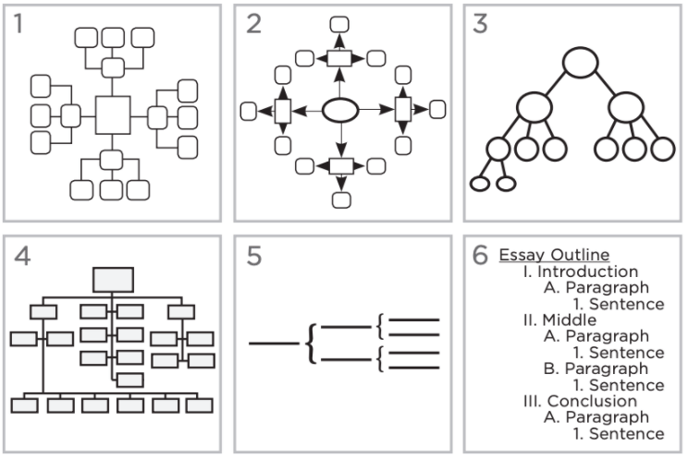
One example of the benefit of adding D, R, and P to the hierarchies of S is in outlining (a task for which Mind Maps is often used in school). The outline has been used for centuries as a simple yet powerful tool for laying out a sequence of ideas in preparation to create a written work. The traditional outline uses Roman numerals to generate a simple, hierarchical part-whole structure. This same traditional approach is taught in classrooms and used by writers around the world. Yet teachers often complain that students fail to write in a way that relates one part of an essay to another. Clearly outlines may not be serving us well.
The solution to this problem is to help learners see both the underlying structure of writing and what’s missing from a typical outline. A traditional outline has only part-whole structure and distinctions. That is, each item in the outline is (presumably) a distinct idea and the ideas in an outline are placed in hierarchical or part-whole structure.
When written works lack a coherent thread, it’s because writers are putting a bunch of ideas into a part-whole structure but failing to think about the relationships that link them all together. This can be remedied by incorporating relationships. The simple rule is to relate each section to the one that follows using a part of the preceding section that we call a transition (see Figure 8.16). A transition relates one section of writing to the next. Depending on the scope of the writing project it could be a few words, a single sentence, a paragraph, or several pages. Both the introduction and the conclusion of written work should relate to each other and to the interior sections of the document.
To extend the power of traditional outlines even further, we can add perspectives (see Figure 8.17). Perspectives can be thought of as parts or sections of the document that provide “framing” for other parts—a lens through which the author is approaching other ideas. For example, in Figure 8.17, we have thought of the first section of the beginning, middle, and end as perspectives on the section. Here the author might lay down some of the assumptions, presumptions, precepts, or concepts that govern the discussion that follows, keying the reader into the point of view taken by the author.
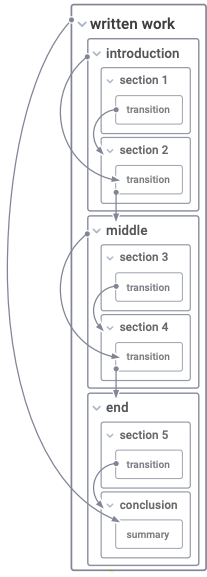
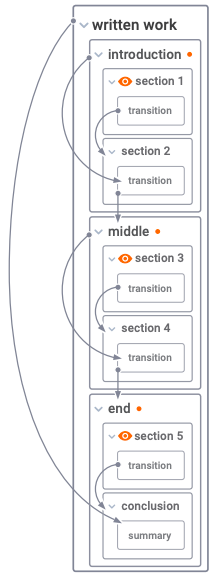
By adding DSRP structure to traditional outlines, students focus not merely on the information that goes into each section, but on the structure of their written work (e.g., the relationships between sections) and how to better communicate their ideas to the reader.
 Plectica
Plectica
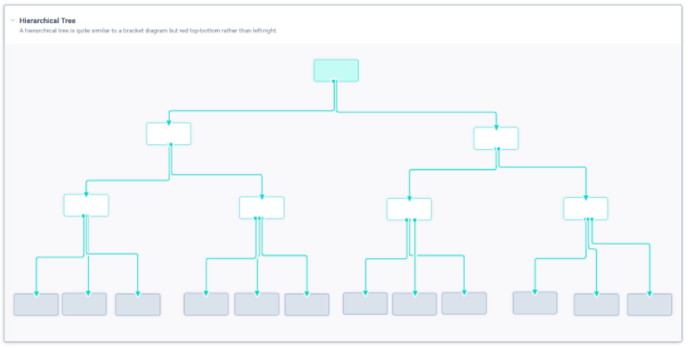
.png?width=150&height=150&name=CRL%20GOAT%20Logo%20(4).png)


